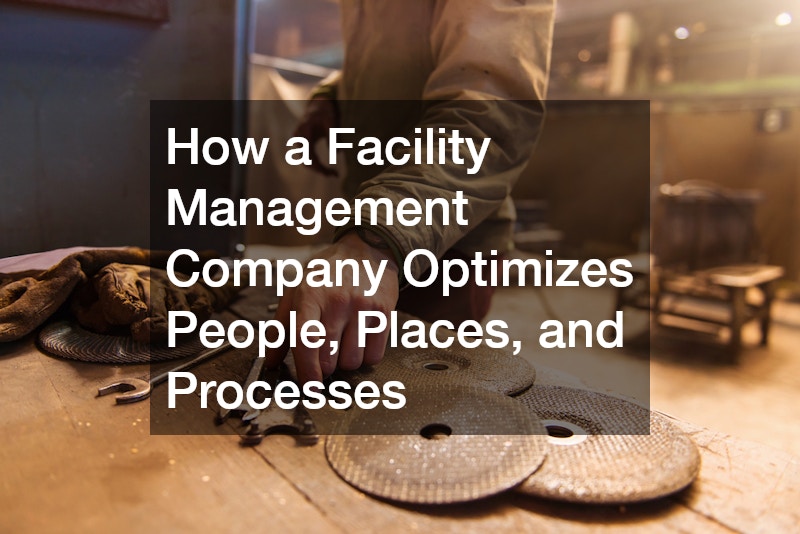Facilities management plays a critical role in the smooth and efficient operation of corporate buildings, campuses, and workspaces. It focuses on the coordination of people, places, and processes, creating a harmonious environment where businesses can thrive. A well-run facilities management company optimizes these three pillars to enhance employee productivity, reduce operational costs, and maintain a high standard of safety and compliance.
Let’s explore how this optimization takes place across various aspects of corporate facilities.
1. Managing People: A Core Element of Facilities Management One of the key responsibilities of a facilities management company is the effective management of people within an organization. Employees, contractors, visitors, and even students who use a facility need adequate space, resources, and support to function efficiently.
For this reason, a comprehensive personnel list is essential. This list must include detailed information about where each employee or user is located, their department, and their movement history within the organization. Access to real-time personnel data ensures the seamless coordination of day-to-day operations. In many cases, facilities management companies will integrate their systems with a company’s human resources department, making it easier to track employee movements, manage seating arrangements, and ensure compliance with organizational policies.
By understanding the layout and distribution of personnel within a building, facilities managers can adjust seating plans, allocate resources more efficiently, and even facilitate team cohesion through strategic seating arrangements. All of these efforts not only improve employee morale but also contribute to better retention and productivity. Employees who work in a well-organized, supportive environment are more likely to stay with a company and perform at a higher level.
2. Optimizing Places: Ensuring Efficient Use of Space Corporate facilities are often one of the largest expenses for an organization, second only to personnel costs. A key goal of any facilities management company is to maximize the utility of these spaces. This means ensuring that workspaces are not only comfortable and functional but also cost-effective.
Each space within a building—whether it’s a work area, meeting room, restroom, or storage facility—should be clearly defined, categorized, and tracked. By assigning unique identifiers to every room and establishing clear boundaries, a facilities management company can keep detailed records of room sizes, occupancy rates, and space utilization.
Modern facilities management solutions often incorporate computer-aided design (CAD) tools and other digital resources to keep floor plans up-to-date. These systems allow for real-time updates and visual reports on how space is being used. For example, a facilities manager can generate reports on underutilized or overutilized areas, making it easier to reassign spaces as needed. If a company is expanding and needs to relocate staff or departments, having access to accurate space data can minimize downtime and ensure a smooth transition.
Efficient use of space doesn’t just save money; it also creates a more dynamic and adaptable workplace. Facilities management companies ensure that spaces are flexible enough to accommodate changes, whether that means adding new employees, upgrading office equipment, or reconfiguring workstations to comply with health and safety regulations.
3. Streamlining Processes: Building a Solid Operational Framework Processes are the backbone of effective facilities management. Whether it’s overseeing maintenance tasks, managing moves, or ensuring compliance with health and safety standards, every task follows a defined set of procedures to ensure efficiency and consistency.
A good facilities management company will have refined processes for handling everyday activities as well as unexpected issues. For instance, preventive maintenance is critical to avoiding costly repairs and operational downtime. By scheduling regular checks and upkeep of essential building systems—such as HVAC units, plumbing, and electrical systems—facilities management companies can minimize the risk of failure and extend the lifespan of assets.
Additionally, the management of moves, adds, and changes (MAC) is another essential process in facilities management. Whether it’s relocating personnel, adjusting office layouts, or integrating new technologies, a clear and organized process is vital to minimize disruptions. Facilities management companies utilize databases and tracking systems to manage MAC processes, ensuring all stakeholders are informed at each step, and work can proceed without unnecessary delays.
A well-structured work order system is also crucial for responding to service requests, tracking progress, and maintaining a complete history of maintenance activities. Such systems allow facilities managers to prioritize tasks based on urgency, allocate resources efficiently, and ensure transparency across the organization.
4. Leveraging Technology: The Driving Force of Modern Facilities Management Technology is central to the success of facilities management in the modern workplace. From cloud computing to mobile apps, technological tools enable real-time access to data, streamline processes, and improve overall efficiency.
A key example is the integration of facility management software with human resources systems to automatically update personnel and occupancy data. This eliminates the need for manual data entry and ensures that reports on space utilization and occupancy levels are always accurate and current.
Facilities management technology also allows for the automation of routine tasks, such as sending out email notifications when maintenance is scheduled or when a work order has been completed. Automated alerts and real-time data access help keep all stakeholders informed, ensuring that tasks are completed on time and within budget.
Another significant technological advancement is the use of intelligent floor plans, which provide facilities managers with the ability to visualize how spaces are being used. These visual reports, often color-coded and easy to understand, offer insights into space allocation, utilization rates, and potential areas for improvement.
Conclusion In summary, a facilities management company optimizes people, places, and processes by leveraging detailed data, refined procedures, and advanced technology. By maintaining up-to-date records of personnel, spaces, and operational tasks, facilities managers ensure that corporate environments run smoothly and efficiently. These optimizations not only reduce costs but also create a workplace where employees feel supported, productive, and valued. With the right facilities management strategies in place, companies can focus on their core business goals, knowing that their operations are in capable hands.
.


